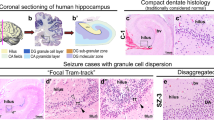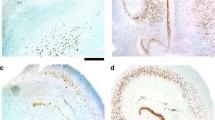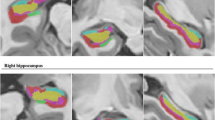Abstract
The dentate gyrus (DG) plays a pivotal role in the functional and anatomical organization of the hippocampus and is involved in learning and memory formation. However, the impact of structural DG abnormalities, i.e., granule cell dispersion (GCD), for hippocampal seizure susceptibility and its association with distinct lesion patterns in epileptic disorders, such as mesial temporal sclerosis (MTS) remains enigmatic and a large spectrum of pathological changes has been recognized. Here, we propose a clinico-pathological classification of DG pathology based on the examination of 96 surgically resected hippocampal specimens obtained from patients with chronic temporal lobe epilepsy (TLE). We observed three different histological patterns. (1) A normal granule cell layer was identified in 11 patients (no-GCP; 18.7%). (2) Substantial granule cell loss was evident in 36 patients (referred to as granule cell pathology (GCP) Type 1; 37.5%). (3) Architectural abnormalities were observed in 49 specimens, including one or more of the following features: granule cell dispersion, ectopic neurons or clusters of neurons in the molecular layer, or bi-lamination (GCP Type 2; 51%). Cell loss was always encountered in this latter cohort. Seventy-eight patients of our present series suffered from MTS (81.3%). Intriguingly, all MTS patients displayed a compromised DG, 31 (40%) with significant cell loss (Type 1) and 47 (60%) with GCD (Type 2). In 18 patients without MTS (18.7%), seven displayed focally restricted DG abnormalities, either cell loss (n = 5) or GCD (n = 2). Clinical histories revealed a significant association between DG pathology patterns and higher age at epilepsy surgery (p = 0.008), longer epilepsy duration (p = 0.004), but also with learning dysfunction (p < 0.05). There was no correlation with the extent of pyramidal cell loss in adjacent hippocampal segments nor with postsurgical seizure relief. The association with long-term seizure histories and cognitive dysfunction is remarkable and may point to a compromised regenerative capacity of the DG in this cohort of TLE patients.


Similar content being viewed by others
References
Becker AJ, Gillardon F, Blümcke I, Langendorfer D, Beck H, Wiestler OD (1999) Differential regulation of apoptosis-related genes in resistant and vulnerable subfields of the rat epileptic hippocampus. Mol Brain Res 67:172–176
Bien CG, Schulze-Bonhage A, Deckert M, Urbach H, Helmstaedter C, Grunwald T, Schaller C, Elger CE (2000) Limbic encephalitis not associated with neoplasm as a cause of temporal lobe epilepsy. Neurology 55:1823–1828
Blumcke I, Beck H, Lie AA, Wiestler OD (1999) Molecular neuropathology of human mesial temporal lobe epilepsy. Epilepsy Res 36:205–223
Blumcke I, Pauli E, Clusmann H, Schramm J, Becker A, Elger C, Merschhemke M, Meencke HJ, Lehmann T, von Deimling A, Scheiwe C, Zentner J, Volk B, Romstock J, Stefan H, Hildebrandt M (2007) A new clinico-pathological classification system for mesial temporal sclerosis. Acta Neuropathol 113:235–244
Blumcke I, Schewe JC, Normann S, Brustle O, Schramm J, Elger CE, Wiestler OD (2001) Increase of nestin-immunoreactive neural precursor cells in the dentate gyrus of pediatric patients with early-onset temporal lobe epilepsy. Hippocampus 11:311–321
Blumcke I, Thom M, Wiestler OD (2002) Ammon’s horn sclerosis: a maldevelopmental disorder associated with temporal lobe epilepsy. Brain Pathol 12:199–211
Blumcke I, Zuschratter W, Schewe JC, Suter B, Lie AA, Riederer BM, Meyer B, Schramm J, Elger CE, Wiestler OD (1999) Cellular pathology of hilar neurons in Ammon’s horn sclerosis. J Comp Neurol 414:437–453
Clusmann H, Kral T, Gleissner U, Sassen R, Urbach H, Blumcke I, Bogucki J, Schramm J (2004) Analysis of different types of resection for pediatric patients with temporal lobe epilepsy. Neurosurgery 54:847–859 discussion 859-860
Clusmann H, Kral T, Schramm J (2006) Present practice and perspective of evaluation and surgery for temporal lobe epilepsy. Zentralbl Neurochir 67:165–182
Clusmann H, Schramm J, Kral T, Helmstaedter C, Ostertun B, Fimmers R, Haun D, Elger CE (2002) Prognostic factors and outcome after different types of resection for temporal lobe epilepsy. J Neurosurg 97:1131–1141
Crespel A, Rigau V, Coubes P, Rousset MC, de Bock F, Okano H, Baldy-Moulinier M, Bockaert J, Lerner-Natoli M (2005) Increased number of neural progenitors in human temporal lobe epilepsy. Neurobiol Dis 19:436–450
D’Arcangelo G, Miao GG, Chen SC, Soares HD, Morgan JI, Curran T (1995) A protein related to extracellular matrix proteins deleted in the mouse mutant reeler. Nature 374:719–723
de Lanerolle NC, Kim JH, Williamson A, Spencer SS, Zaveri HP, Eid T, Spencer DD (2003) A retrospective analysis of hippocampal pathology in human temporal lobe epilepsy: evidence for distinctive patient subcategories. Epilepsia 44:677–687
Del Rio JA, Heimrich B, Borrell V, Förster E, Drakew A, Alcantara S, Nakajima K, Miyata T, Ogawa M, Mikoshiba K, Derer P, Frotscher M, Soriano E (1997) A role for Cajal-Retzius cells and reelin in the development of hippocampal connections. Nature 385:70–74
Duvernoy HM (2005) The human hippocampus: functional anatomy, vascularization and serial sections with MRI. Springer, Berlin
El Bahh B, Lespinet V, Lurton D, Coussemacq M, Le Gal La Salle G, Rougier A (1999) Correlations between granule cell dispersion, mossy fiber sprouting, and hippocampal cell loss in temporal lobe epilepsy. Epilepsia 40:1393–1401
Engel J Jr, Van Ness PC, Rasmussen TB, Ojemann LM (1993) Outcome with respect to epileptic seizures. In: Engel J Jr (ed) Surgical treatment of the epilepsies. Raven Press, New York, pp 609–621
Eriksson PS, Perfilieva E, Bjork-Eriksson T, Alborn AM, Nordborg C, Peterson DA, Gage FH (1998) Neurogenesis in the adult human hippocampus. Nat Med 4:1313–1317
Fahrner A, Kann G, Flubacher A, Heinrich C, Freiman TM, Zentner J, Frotscher M, Haas CA (2007) Granule cell dispersion is not accompanied by enhanced neurogenesis in temporal lobe epilepsy patients. Exp Neurol 203:320–332
Frotscher M, Haas CA, Forster E (2003) Reelin controls granule cell migration in the dentate gyrus by acting on the radial glial scaffold. Cereb Cortex 13:634–640
Haas CA, Dudeck O, Kirsch M, Huszka C, Kann G, Pollak S, Zentner J, Frotscher M (2002) Role for reelin in the development of granule cell dispersion in temporal lobe epilepsy. J Neurosci 22:5797–5802
Harding B, Thom M (2001) Bilateral hippocampal granule cell dispersion: autopsy study of 3 infants. Neuropathol Appl Neurobiol 27:245–251
Heinrich C, Nitta N, Flubacher A, Muller M, Fahrner A, Kirsch M, Freiman T, Suzuki F, Depaulis A, Frotscher M, Haas CA (2006) Reelin deficiency and displacement of mature neurons, but not neurogenesis, underlie the formation of granule cell dispersion in the epileptic hippocampus. J Neurosci 26:4701–4713
Houser CE, Miyashiro JE, Swartz BE, Walsh GO, Rich JR, Delgado-Escueta VA (1990) Altered patterns of dynorphin immunoreactivity suggest mossy fiber reorganization in human hippocampal epilepsy. J Neurosci 10:267–282
Houser CR (1990) Granule cell dispersion in the dentate gyrus of humans with temporal lobe epilepsy. Brain Res 535:195–204
Houser CR (1992) Morphological changes in the dentate gyrus in human temporal lobe epilepsy. Epilepsy Res Suppl 7:223–234
Janszky J, Janszky I, Schulz R, Hoppe M, Behne F, Pannek HW, Ebner A (2005) Temporal lobe epilepsy with hippocampal sclerosis: predictors for long-term surgical outcome. Brain 128:395–404
Kesner RP, Lee I, Gilbert P (2004) A behavioral assessment of hippocampal function based on a subregional analysis. Rev Neurosci 15:333–351
Kobow K, Jeske I, Hildebrandt M, Hauke J, Hahnen E, Buslei R, Buchfelder M, Weigel D, Stefan H, Kasper BS, Pauli E, Blumcke I (2009) Increased Reelin promoter methylation associates with granule cell dispersion in human temporal lobe epilepsy. J Neuropathol Exp Neurol (in press)
Leuner B, Mendolia-Loffredo S, Kozorovitskiy Y, Samburg D, Gould E, Shors TJ (2004) Learning enhances the survival of new neurons beyond the time when the hippocampus is required for memory. J Neurosci 24:7477–7481
Lurton D, El Bahh B, Sundstrom L, Rougier A (1998) Granule cell dispersion is correlated with early epileptic events in human temporal lobe epilepsy. J Neurol Sci 154:133–136
Maguire EA, Gadian DG, Johnsrude IS, Good CD, Ashburner J, Frackowiak RS, Frith CD (2000) Navigation-related structural change in the hippocampi of taxi drivers. Proc Natl Acad Sci USA 97:4398–4403
Mathern GW, Babb TL, Vickrey BG, Melendez M, Pretorius JK (1995) The clinical-pathogenic mechanisms of hippocampal neuron loss and surgical outcomes in temporal lobe epilepsy. Brain 118:105–118
Mathern GW, Kuhlman PA, Mendoza D, Pretorius JK (1997) Human fascia dentata anatomy and hippocampal neuron densities differ depending on the epileptic syndrome and age at first seizure. J Neuropathol Exp Neurol 56:199–212
Mathern GW, Leiphart JL, De Vera A, Adelson PD, Seki T, Neder L, Leite JP (2002) Seizures decrease postnatal neurogenesis and granule cell development in the human fascia dentata. Epilepsia 43(Suppl 5):68–73
Parent JM, Yu TW, Leibowitz RT, Geschwind DH, Sloviter RS, Lowenstein DH (1997) Dentate granule cell neurogenesis is increased by seizures and contributes to aberrant network reorganization in the adult rat hippocampus. J Neurosci 17:3727–3738
Pauli E, Hildebrandt M, Romstock J, Stefan H, Blumcke I (2006) Deficient memory acquisition in temporal lobe epilepsy is predicted by hippocampal granule cell loss. Neurology 67:1383–1389
Rakic P, Caviness VS Jr (1995) Cortical development: view from neurological mutants two decades later. Neuron 14:1101–1104
Scharfman HE, Goodman JH, Sollas AL (2000) Granule-like neurons at the hilar/CA3 border after status epilepticus and their synchrony with area CA3 pyramidal cells: functional implications of seizure-induced neurogenesis. J Neurosci 20:6144–6158
Scoville WB, Milner B (1957) Loss of recent memory after bilateral hippocampal lesions. J Neurol Neurosurg Psychiatry 20:11–21
Shors TJ, Miesegaes G, Beylin A, Zhao M, Rydel T, Gould E (2001) Neurogenesis in the adult is involved in the formation of trace memories. Nature 410:372–376
Siebzehnrubl F, Blumcke I (2008) Neurogenesis in the human hippocampus and its relevance to temporal lobe epilepsies. Epilepsia 49:55–65
Squire LR, Stark CE, Clark RE (2004) The medial temporal lobe. Annu Rev Neurosci 27:279–306
Stefan H, Hildebrandt M, Kerling F, Kasper B, Hammen T, Doerfler A, Weigel D, Buchfelder M, Blumcke I, Pauli E (2009) Clinical prediction of postoperative seizure control: structural, functional findings and disease histories. J Neurol Neurosurg Psychiatry 80(2):196–200
Thom M, Martinian L, Williams G, Stoeber K, Sisodiya SM (2005) Cell proliferation and granule cell dispersion in human hippocampal sclerosis. J Neuropathol Exp Neurol 64:194–201
Thom M, Zhou J, Martinian L, Sisodiya S (2005) Quantitative post-mortem study of the hippocampus in chronic epilepsy: seizures do not inevitably cause neuronal loss. Brain 128:1344–1357
van Praag H, Schinder AF, Christie BR, Toni N, Palmer TD, Gage FH (2002) Functional neurogenesis in the adult hippocampus. Nature 415:1030–1034
von Lehe M, Lutz M, Kral T, Schramm J, Elger CE, Clusmann H (2006) Correlation of health-related quality of life after surgery for mesial temporal lobe epilepsy with two seizure outcome scales. Epilepsy Behav 9:73–82
Wieser HG (2004) ILAE Commission Report: mesial temporal lobe epilepsy with hippocampal sclerosis. Epilepsia 45:695–714
Zeineh MM, Engel SA, Thompson PM, Bookheimer SY (2003) Dynamics of the hippocampus during encoding and retrieval of face-name pairs. Science 299:577–580
Zhao S, Chai X, Forster E, Frotscher M (2004) Reelin is a positional signal for the lamination of dentate granule cells. Development 131:5117–5125
Acknowledgments
We kindly acknowledge the technical assistance of Silke Sterner and Birte Rings. The work is supported by the German research council (DFG Bl 421/1-2; SFB TR3 A1 & C6), the European Community (LSH-CT-2006-037315 EPICURE), and Elan-Fond of the Faculty of Medicine (University of Erlangen-Nuremberg). The Neuropathological Reference Center for Epilepsy Surgery is a consortium of colleagues from the following German epilepsy centers: Berlin: H.J. Meencke, M. Merschhemke, N.T. Lehmann. Bielefeld: V. Hans, A. Ebner, H·W. Pannek, F. Woermann. Bonn: A. Becker, P. Niehusmann, C. Elger, C. G. Bien, C. Helmstaedter, J. Schramm, H. Clusmann, H. Urbach. Erlangen: I. Blümcke, M. Hildebrandt, R. Buslei, R. Coras, H. Stefan, B. Kasper, E. Pauli, M. Buchfelder, D. Weigel, A. Dörfler, T. Engelhorn. Freiburg/Kehl-Kork: B. Steinhoff, A. Schulze-Bonhage, S. Fauser, J. Zentner, C. Scheiwe. Greifswald: S. Vogelgesang. Marburg: F. Rosenow, H. Hamer, S. Knake. Munich: P.A. Winkler, S. Noachtar. Munster: W. Paulus. Radeberg: K. Grohme, T. Mayer. Stuttgart: P. Winkler. Ulm: H. Lerche, Y. Wagner. Vogtareuth: H. Holthausen, T. Pieper.
Author information
Authors and Affiliations
Corresponding author
Rights and permissions
About this article
Cite this article
Blümcke, I., Kistner, I., Clusmann, H. et al. Towards a clinico-pathological classification of granule cell dispersion in human mesial temporal lobe epilepsies. Acta Neuropathol 117, 535–544 (2009). https://doi.org/10.1007/s00401-009-0512-5
Received:
Revised:
Accepted:
Published:
Issue Date:
DOI: https://doi.org/10.1007/s00401-009-0512-5




